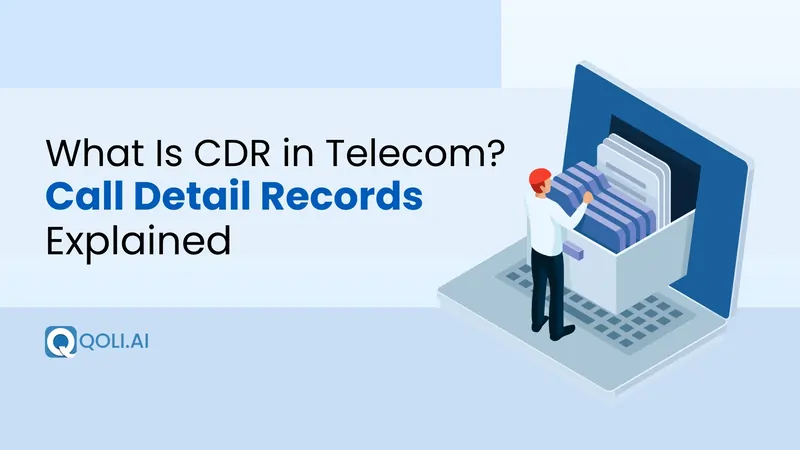What Is CDR in Telecom? Call Detail Records Explained
CDR in telecom explained simply, see what’s inside a call record, why it matters, and how it powers billing, fraud prevention, network use, and insights.
Author: Sujith Grandhi
CDR in telecom explained simply, see what’s inside a call record, why it matters, and how it powers billing, fraud prevention, network use, and insights.
Author: Sujith Grandhi

Every phone call leaves a trail. When you dial a number or receive one, your telecom operator automatically generates a Call Detail Record (CDR). Think of it as the digital receipt of a call, capturing the caller and receiver numbers, time, duration, and other key details.
So, what is CDR in telecom? It’s much more than a technical log. In telecom, CDR is the backbone of telecom operations, powering billing systems, detecting fraud, supporting customer service, and helping businesses make smarter decisions. Without them, operators couldn’t charge accurately, companies couldn’t track call performance, and law enforcement couldn’t trace suspicious activity.
In this guide, you’ll learn what CDR means in telecom, what information it contains, why it matters, and how organizations use it in real-world scenarios.
In telecommunications, CDR stands for Call Detail Record. It is a log of all chargeable communication events, including calls, SMS, or data usage, recorded by a service provider.
A CDR contains important information such as the calling and called parties, timestamps, duration, and location. These records are essential for billing, network management, fraud detection, and supporting law enforcement investigations.
Each Call Detail Record (CDR) captures key details about a specific communication event, without recording the actual conversation. Common information found in a CDR includes:
This structured information allows telecom providers and businesses to analyze usage patterns, improve service quality, and manage resources effectively, making CDRs a vital tool in telecom operations. Understanding the CDR meaning helps you know what details each record contains.
👉 You Might Like This: How to check Call History of Any Number Online Safely
Call Detail Records (CDRs) play a vital role in both telecom operations and business decision-making. Their importance can be seen in several key areas:
In short, CDRs are essential for transparency, accountability, and informed decision-making, making them a cornerstone of telecom operations and business intelligence.
Call Detail Records (CDRs) are sensitive, so access is highly restricted. Only a few parties can view them:
CDR data isn’t just stored, it’s actively used by telecom operators, businesses, and authorities in different ways:
Tracking Call Detail Records manually can be complex and time-consuming. That’s where Qoli makes things simple. With Qoli, you get more than just call log monitoring, you get a complete employee monitoring solution.
Qoli gives you the power to:
Instead of just storing CDRs, Qoli transforms them into actionable insights, helping your business improve performance, security, and transparency.
For businesses, Call Detail Records (CDRs) are more than technical logs, they’re a goldmine of insights. Monitoring them can help you:
Actively monitoring CDRs gives you clarity, control, and confidence over how communication happens in your business. Studies show that analyzing CDRs with predictive models helps forecast subscriber behavior, churn, and service usage, enabling smarter decisions.
To understand CDRs better, let’s look at how they appear in real situations:
1. Telecom Billing Example
A customer makes a 5-minute international call. The CDR logs the caller’s number, receiver’s number, call start/end time, duration, and rate applied. This record ensures the customer is billed correctly.
2. Business Performance Example
A sales team’s calls to clients are logged in CDRs. Managers can review missed calls, average talk time, and peak calling hours to improve productivity and client follow-ups.
3. Fraud Detection Example
A sudden spike in late-night international calls triggers alerts. By checking CDRs, the telecom provider identifies suspicious usage and blocks the fraudulent activity.
4. Law Enforcement Example
Investigators analyze CDRs to establish timelines of communication between suspects, helping track movements and build evidence in a case.
These examples show how CDRs are not just technical data, they’re practical tools for billing, business insights, security, and investigations.
In simple terms, a call detail record is the digital footprint of every communication. In telecom, CDRs serve as a reliable source of truth, powering accurate billing, fraud detection, network optimization, and business insights.
For organizations, understanding what CDR is in telecom means knowing how to use call data for smarter decisions and stronger security. With the right tools, these records turn from static logs into actionable intelligence that helps businesses stay efficient and future-ready.
Understanding Call Detail Records is the first step to turning raw call data into valuable insights!